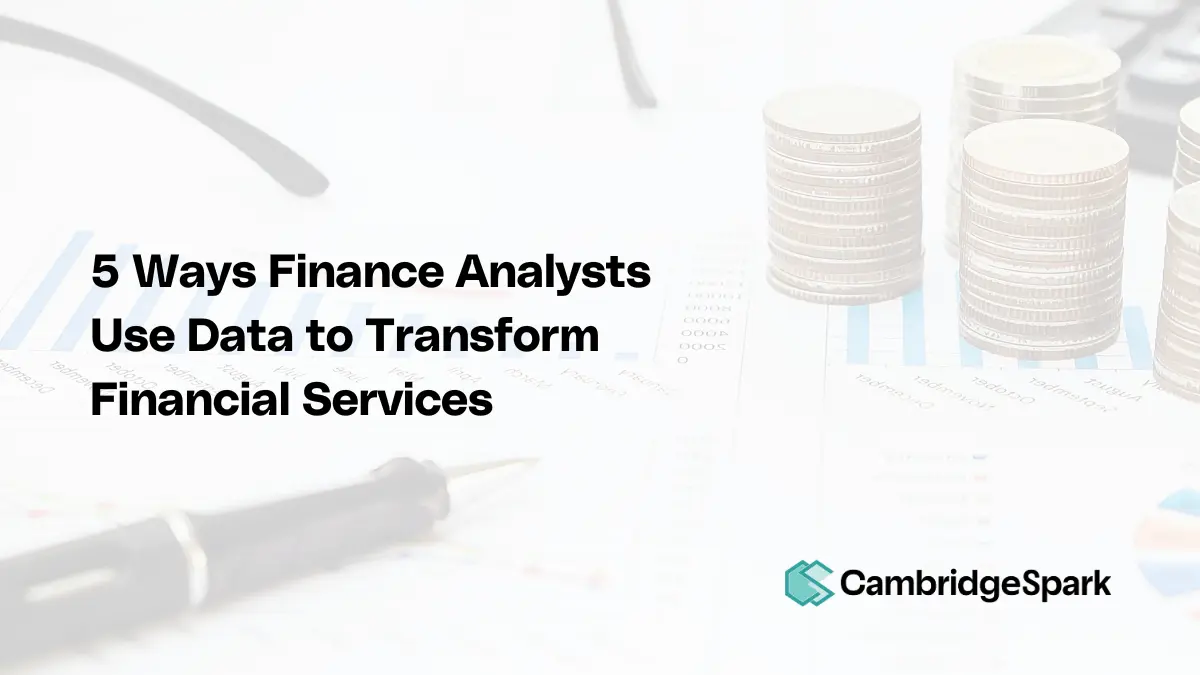According to the Robert Half 2024 salary guide, financial analyst is now the most in-demand job in the finance industry.
But where is data analysis used in the finance industry?
Data analytics in finance refers to the process of examining vast amounts of financial data to uncover hidden patterns, correlations, and insights. Using a blend of statistical techniques, algorithms, and analysis tools, analysts transform raw data into meaningful information.
This process plays a crucial role in decision-making, enabling firms to:
- Forecast market trends
- Assess risks
- Personalise customer services, and
- Enhance operational efficiency
Let’s take a look at 5 ways that finance analysts are using data to transform their organisations.
1. Enhanced risk assessment and management
Data analytics has become key in transforming how financial institutions assess and manage risks. This shift towards data-driven decision-making enables firms to dissect and understand risk in more complex ways.
By harnessing vast amounts of data and employing advanced analytical techniques, finance analysts can uncover hidden risk factors and correlations that may have previously been undetectable.
Credit risk
One of the key applications of finance analytics in risk assessment is in the realm of credit risk. Financial institutions now can delve deeper into a customer's financial history, lifestyle choices, and even social media behaviour. Firms are then able to predict customer creditworthiness more accurately.
This approach not only helps in identifying high-risk borrowers but also in crafting personalised loan offerings that align with the borrower's profile, reducing the likelihood of default.
Market risk
Market risk analysis has also been revolutionised by data analytics. Finance professionals are able to analyse historical market data, current economic indicators, and even sentiment analysis from news and social media. They can then use this data to forecast market trends and volatility more reliably.
This insight is vital to financial institutions making effective investment decisions and in hedging against potential market downturns.
Operational risk
Operational risk management, a critical aspect often overshadowed by market and credit risks, is also benefiting from data analytics. Financial institutions are now using data to streamline their operations, predict and prevent system failures, and combat fraud.
This proactive approach in identifying and mitigating operational risks both safeguards the institution and boosts customer confidence in the system.
The integration of data analytics into risk assessment and management signals a major shift in the finance sector. It empowers financial institutions to foresee and navigate through the myriad of risks in today's dynamic financial landscape, ensuring stability.
 "My department is focused on the availability of external data and how we can use data science techniques to strengthen our strategies and improve our risk definitions. We can apply data science to many areas of the business including fraud prevention, risk management, credit allocation and customer analytics.”
"My department is focused on the availability of external data and how we can use data science techniques to strengthen our strategies and improve our risk definitions. We can apply data science to many areas of the business including fraud prevention, risk management, credit allocation and customer analytics.”
-Preeti Maurya, Credit Risk Analyst, NewDay

2. Personalised customer services
Ninety percent of leading marketers say personalisation significantly contributes to business profitability. And when it comes to the finance industry, a personalised touch in customer interactions has become a key differentiator for firms.
Financial services firms are making big strides in understanding customer preferences and behaviours through data analytics. And deep insights are transforming the traditional approach to customer service, making it more tailored and responsive to individual needs.
Thanks to data analysis tools like Python, firms can now aggregate and analyse vast amounts of customer data more efficiently. From transaction histories to online interactions, datapoint offers a glimpse into the customer's financial journey.
Personalised investment management
This customisation ranges across various aspects of financial services. In investment management, for instance, firms are providing customised investment advice, taking into account the individual's risk appetite, financial goals, and past investment behaviours.
This ensures a more suitable investment strategy for each client and fosters a sense of trust and alignment with the financial advisor.
Individualised marketing and communications
When it comes to marketing and communication, personalisation has taken a significant leap. Financial firms are now using insights from data analytics to create individualised marketing strategies.
By understanding the unique financial needs and lifestyle choices of each customer, these firms can deliver targeted offers and messages that are more likely to resonate and engage. This approach enhances the effectiveness of marketing campaigns and strengthens the customer's connection to the brand.

3. Fraud detection and prevention
Finance analysts are increasingly turning to data analysis to bolster their defences against fraudulent activities too. And this is proving to be an effective and necessary move.
The integration of complex analytics and machine learning into fraud detection systems marks a major advancement over traditional methods. These technologies have the capability to process and analyse lots of data with unprecedented speed and accuracy.
Machine learning for pattern recognition
Machine learning models rely heavily on pattern recognition. By analysing transaction patterns and customer behaviour, these models can identify deviations from the norm that may indicate fraudulent activity.
For instance, a sudden spike in high-value transactions from an account that typically shows low activity can trigger an alert. Similarly, machine learning algorithms can detect complex patterns of transactions that are typical of sophisticated fraud schemes, something that would be nearly impossible for human analysts to identify quickly.
Applying data analysis techniques to fraud detection and prevention strategies has numerous benefits, including:
- Significantly reducing the time taken to detect fraud, thereby minimising potential losses.
- Improving the accuracy of fraud detection and reducing false positives that can inconvenience legitimate customers.
- Providing a dynamic defence mechanism that constantly learns and adapts to new fraudulent tactics.
This enhanced capability in detecting and preventing fraud is crucial not just in protecting the financial assets of institutions but also in safeguarding customer trust. In an era where digital transactions have become the norm, customers demand both convenience AND security.

4. Operational efficiency
Financial analysts are also using data-driven insights to drive improvements in operational efficiency. And in doing so, they’re becoming an asset to other departments in their organisations as well.
Automating reporting at Visa
Imran Ayad, Data Analyst at Visa, applied his skills, developed during the Cambridge Spark Level 4 Data Analyst Apprenticeship, to improve operational efficiency in his organisation.
 “My team saw the value of data science with Cambridge Spark. Being part of a global organisation such as Visa, teams in other regions would see the benefits of my projects and begin to reach out with enquiries. I would help them in building reports and dashboards relevant to their own unique requirements, as well as provide training to enable self-sufficiency going forward.”
“My team saw the value of data science with Cambridge Spark. Being part of a global organisation such as Visa, teams in other regions would see the benefits of my projects and begin to reach out with enquiries. I would help them in building reports and dashboards relevant to their own unique requirements, as well as provide training to enable self-sufficiency going forward.”
-Imran Ayad, Data Analyst at Visa
Historically, reporting before a client meeting would take Imran’s team several hours. Now with the use of interactive dashboards, it takes just 30 seconds of manual intervention from a non-technical stakeholder. This has saved Visa between 25-40 hours in time, in reporting, per client meeting.
Financial services firms are also using analytics to identify inefficiencies and bottlenecks in their processes, leading to more streamlined operations. This not only cuts operational costs but also improves the speed and quality of service delivery, a critical factor in customer satisfaction.

5. Market trend analysis and forecasting
The ability to anticipate market movements is akin to holding a crystal ball in the finance industry. Data analytics has emerged as this “crystal ball”, giving financial firms powerful tools to analyse market trends and forecast future market dynamics with greater accuracy.
Financial firms are delving into years, sometimes decades, of market data to unearth patterns and trends that signal future movements. This historical analysis isn’t limited to mere price movements. It encompasses a range of variables, including trading volumes, market volatility, and even the impact of geopolitical events.
Such in-depth analysis provides a solid base for understanding market behaviours and preparing for similar scenarios in the future.
Analysing market sentiment
Beyond historical data, another critical aspect where data analytics is proving invaluable is in analysing market sentiment. Natural language processing (NLP) tools can gauge the mood and outlook of the market by scraping and analysing text from vast amounts of news, social media feeds, and financial reports.
This sentiment analysis, when combined with traditional financial metrics, gives a more rounded view of the market dynamics.
The integration of economic indicators into analytics models adds another layer of precision to market forecasts. Financial firms are using these indicators to understand how factors like interest rate changes, inflation rates, and unemployment rates influence financial markets.
This enables firms to predict not just stock market trends but also other critical financial dynamics like bond yields and currency fluctuations.

Conclusion
The future of finance is undeniably intertwined with data analytics. And finance analysts are at the helm of this revolution, steering organisations towards greater efficiency, security, and profitability.
As the industry continues to evolve, the role of data and those who adeptly analyse it will only grow in significance, marking a new era in financial services.
If you’re interested in learning data analysis to enhance your finance role, get in touch via the form below or find out more about our Level 4 Data Analyst Apprenticeship.
